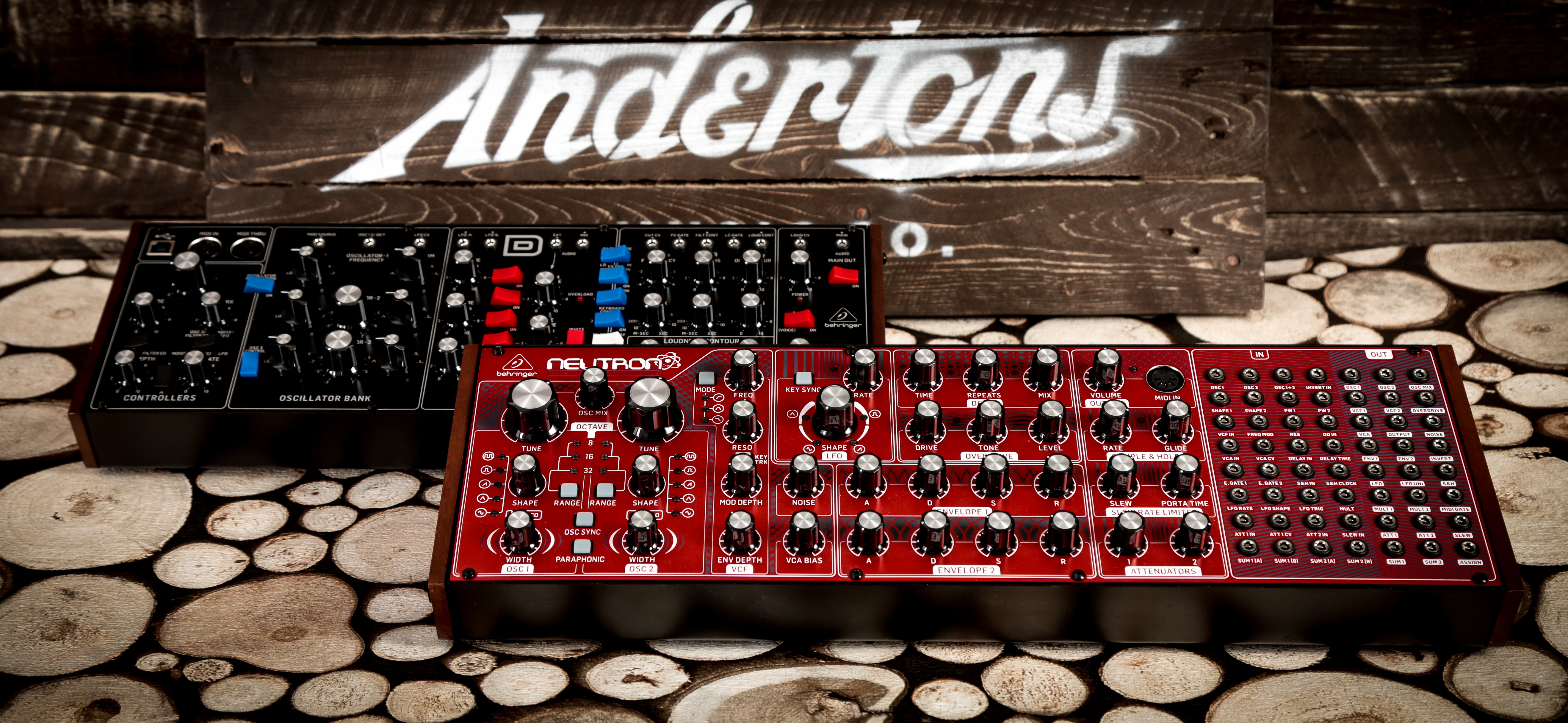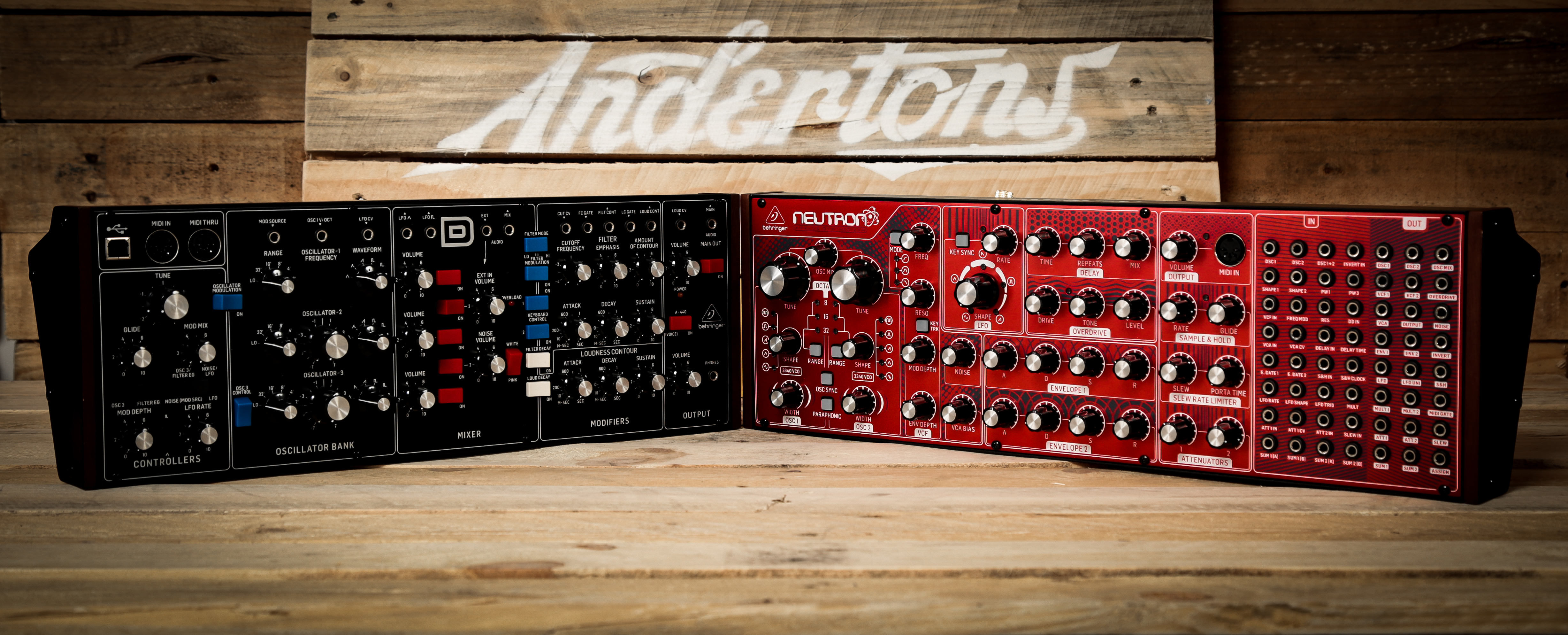Here’s what we’ll be comparing:
- Sound – the tonal quality of each one
- Tech specs – the features that set them apart from each other
- Design – how do they look and feel?
- Connectivity – patching, syncing, recording, the works
But first, here’s the Model D & Neutron in a nutshell.
The Behringer Model D – summary
The monophonic Model D is, as the name suggests, a copy of the Moog Minimoog Model D. But while the Minimoog was a sizeable unit, housed in a wooden frame with a built-in keyboard, the Behringer version (sometimes referred to as the Boog) comes in the form of a compact desktop module approximately half the size. The controls are uncanny, laid out in an almost identical fashion with a few additions, and the sound is as gloriously rich as you’d expect a Model D clone to be. 3 oscillators, a classic filter sound and intuitive switching make the Model D a surprisingly simple yet punchy synth.
The Behringer Neutron – summary
While Behringer seem to excel at producing synth clones, the Neutron is an original design. Its bright red façade is instantly recognisable, helping it to stand out from the crowd. The paraphonic Neutron has been designed as an all-encompassing synth toolkit; on top of the usual features like VCO, LFO and envelope controls, you’ve got a whopping 56 patch connections as well as a built in overdrive and delay. This allows you to get everything from thumping kick drums to fluttering ambient sequences from the same unit – neat.
|
Model D |
Neutron |
| Polyphony |
Monophonic |
Paraphonic |
| Oscillators |
3 x VCO |
2 x 3340 |
| Filter |
1 x VCF 24dB, low-pass/high-pass |
12 dB State Variable Filter, Highpass/Bandpass/Lowpass modes |
| Waveforms |
6 |
5, blend control |
| LFO |
Triangle, square |
Sine, triangle, saw, square, ramp down |
| Patch connections |
14 |
56 |
| Inputs |
Audio, MIDI, MIDI thru, USB |
Audio, MIDI, MIDI thru, USB |
| Outputs |
Headphones, low output, high output |
Headphones, main output |
| Unique features |
White and pink noise generators, overdrive circuit, fat Moog-style sound |
Built-in BBD delay, overdrive circuit, sample and hold |
| Dimensions |
90 x 374 x 136 mm |
94 x 424 x 136 mm |
Behringer Model D vs. Neutron – Sound Comparison
As mentioned earlier, the Model D is modelled after the classic Minimoog. This design is echoed in the sound as well as the features – classic fat, velvety tones that work brilliantly for basslines and slick lead parts. This is due to the fact that you’ve got 3 oscillators bouncing off each other, as well as that classic Moog-style filter sound.
The Neutron is a different beast entirely. Many users have compared its sound to that of classics such as the OBXa and Jupiter 6 – it must be doing something right! 5 waveforms can be blended, opening up a broader tonal palette. This makes the Neutron a truly diverse piece of kit in terms of its sound.
Behringer Model D vs. Neutron – Feature Comparison
If you check out the comparison table above, you get a pretty neat overview of the differences between the two, specs-wise. The Model D features 14 patch connections, allowing you to tweak your tone and hook it up to other synths. The filtering options are comprehensive, with loudness contour, filter emphasis and keyboard control parameters. This allows you to harness the notorious Moog-style filter to get the most out of your sound. The real stars of the show, however, are the oscillators. They’re simple VCO circuits, but there’s three of them, each with 6 waveforms and 6 octaves. One of these oscillators can be isolated from input control, great for adding drones and pedal notes to your jams.

The Neutron, on paper at least, is the dominant one in terms of features. A whopping 56 patch connections (32 in and 24 out) give you unprecedented control over the signal chain. This is on par with a full-blown modular synth setup. It also means that you can incorporate it into your existing setup or sync it with other synths in many different ways – creativity awaits. The built-in overdrive features drive, tone and level controls, further allowing you to sculpt your sound (on top of the filters, oscillators, pulse width modulation…you get the picture). The bucket brigade delay circuit is gloriously warm, noisy and hypnotic – dial it in subtle for cool polyrhythmic ideas or crank it for swirling abstract ambience. Then there’s sample and hold, slew rate, 2 attenuation controls that can be assigned to whatever you want – the list goes on.
Behringer Model D vs. Neutron – Design Comparison
The Model D’s interface is just as user-friendly as its eerily resemblant distant ancestor. The oscillators are neatly aligned with their respective volume controls, and the filter controls are incredibly easy to navigate. They’ve also dialled up the contrast on the classic Minimoog panel, giving you a jet black interface with red, blue and white controls. Looks a bit like Darth Vader, and we aren’t complaining. Finish it off with subtle wooden cheeks and this thing really does look the part.
Let’s not beat around the bush – the Neutron is bright red and that’s not for everyone. Combined with the increased number of controls and patching options, and it takes a little bit of getting used to. That having been said, the patch controls are neatly organised on the right side of the panel, rather than scattered across it. This makes for a slightly tidier workflow, especially if you’re into your patching. If you can get past the eye-popping red panel, you’ll see that the Neutron is just as well signposted as the Model D.
Behringer Synths on Andertons TV







Responses & Questions